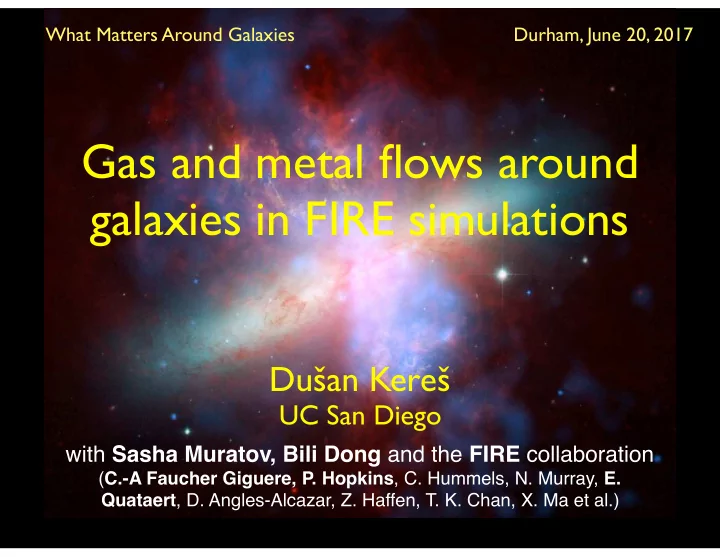

What Matters Around Galaxies Durham, June 20, 2017 Gas and metal flows around galaxies in FIRE simulations Du š an Kere š UC San Diego with Sasha Muratov, Bili Dong and the FIRE collaboration ( C.-A Faucher Giguere, P. Hopkins , C. Hummels, N. Murray, E. Quataert , D. Angles-Alcazar, Z. Haffen, T. K. Chan, X. Ma et al.)
FIRE Project • FIRE resolves ~giant molecular clouds in a multi-phase ISM (m_g~10 2 -10 4 Msun, 1-20pc in dense ISM): enables local SF and spatial and time correlation of stellar feedback. • Includes feedback processes from young stars: photo-ionized HII regions, stellar winds, photoelectric heating, radiation pressure and finally SN energy and momentum. • N o hydro decoupling, no cooling prevention ! • Momentum is crucial: thermal energy cools out, but momentum remains. We carefully account for the radial momentum generated in the S-T phase of the SNe. 50 kpc scale, ~MW mass at z=0 magenta-cold, green-warm, red-hot gas
Star formation driven outflows • FIRE reproduces M*-Mh and mass-metallicity relations: success owes to ejection of metal enriched gas from galaxies. • Star formation in FIRE is bursty! Bursts drive wind episodes that eject gas out of galaxies and create cycle of infall, star formation and outflows. ~10 11 Msun halo (z=2) outflows infall Muratov, Keres et al. 2015
Lack of low redshift outflows • Star formation is more continuous at low redshift, no outflows at 0.25Rvir (only local fountains): enables formation of thin disks! • Key requirement to form late type disky galaxies. Muratov, Keres et al. 2015
How much material is expelled? - Mass loading in inner halo (shell at 0.25Rvir) decreases with stellar mass; << 1 in Milky Way-mass halos at z=0. z~3 z~1 z~0.25 slope ~ -0.35 Muratov, Keres+ 2015
Metal outflows Metallicity of the outflows z~3 z~1 z~0.25 Muratov, DK et al. 2017 • Ejected gas has metallicity similar to the ISM (slightly higher at high-z and slightly lower at low-z and low masses). • Outflows at Rvir have lower metallicity: entrainment of lower metallicity halos gas, especially at z<~2. The bulk of ejected metals remains in halos and recycles back onto galaxies.
• z=2: halos loose about half of the metals and only a small fraction is locked in stars! • z=0: stellar metal fraction overtakes CGM in ~MW mass galaxies. Halos (except smallest dwarfs) keep most of the metals, higher fraction than retained baryons. • The amount of metals in the CGM of L* galaxies broadly agrees with observations (Bouche +2007, Peeples+14). Obs. estimates are uncertain and simulation statistics are poor. • More detailed comparisons are needed: e.g. absorption lines. z=0 z=2 Muratov, Keres et al. 2017
Preliminary: EWs at z~2 for Mh~10^12Msun (e-mail me for details/ figures).
Conclusions • Stellar feedback in FIRE produces galactic outflows that lower galaxy masses and eject material into the CGM and IGM. • Outflows are bursty at low masses and high-z, weak in L* galaxies at low-z. • Most of the metals produced by galaxies stay within virial radius. • Detailed studies are needed for proper comparison with observations: important to have good statistics and/or to capture time evolution of the halo absorbers. • Halo gas is much calmer at low redshift (talks by C. Hummels and N. Murray talks) but shows a strong dependence on resolution.
Recommend
More recommend